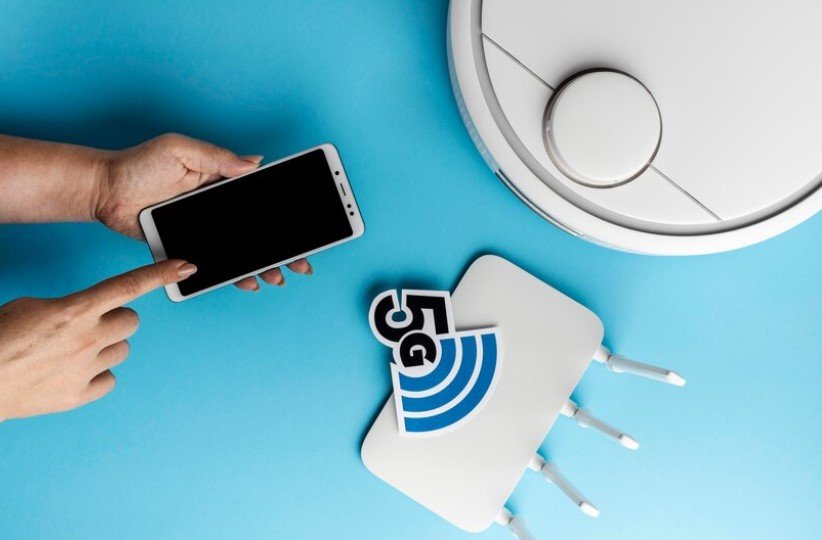Bluetooth and WiFi are the two commonly used communication methods in IoT devices. Although they seem similar, their pros and cons are different. These differences make them ideal for various applications.
Let’s take a look at some of the general specs before diving into detail about which one is better than the other.
| WiFi | Bluetooth | |
| Speed | Up to 10 Gbps | 1 Mbps |
| Security | WPA 3 and WEP | AES-CCM cryptography |
| Location | Less precise but high-range | Precise but low-range |
| Power Usage | High | Low |
| Mobility | Limited | More |
| Onboarding | Configuration required | Consistent |
Now that you know the basic details of WiFi and Bluetooth, let’s compare the two.
Transfer Speeds
Bluetooth is more suitable for transferring small chunks of data as it only has a bandwidth of 1Mbps which is great for lightweight data like values from sensors and signals from devices. However, it isn’t enough to send data in real-time, such as camera video feed and microphone audio.
WiFi, on the other hand, offers varying speeds. WiFi speeds don’t have upper limits which means that more powerful WiFi devices can transfer more data. This makes it great for devices that stream a lot of data, such as cameras and smart TVs.
Detecting Location
Bluetooth Low energy or BLE uses specialized packets for data transfer which allows the host device to get the location data of the BLE device. This is done by detecting the signal strength of the device to estimate the distance between the two devices. Bluetooth 5.1 also has advanced features like Angle of Arrival and Angle of Departure.
WiFi uses the Wireless Local Area Network (WLAN) technology to communicate with devices. This communication method doesn’t rely on the proximity of the device to detect location. Instead, when the device sends its MAC address, it helps the WiFi host to triangulate the location which helps it to detect the location.
Signal Range
WiFi is much better than Bluetooth in terms of range.
WiFi can transmit signals farther since it’s designed to be used in areas like homes and offices to provide internet to further areas from a single point. While this is great for providing more range, it isn’t that good when it comes to precise tracking of devices. Generally, WiFi has a range of 150 feet.
Although Bluetooth is great for precise tracking, it only offers a range of 30 feet. The range also depends on the number of walls between the devices and the density of the walls.
Power Usage
Power usage for Bluetooth devices is a lot lower compared to WiFi devices.
Due to this, Bluetooth is mostly used in battery-powered devices since it uses less than ten times the power used by WiFi devices.
WiFi adapters generally require more energy to work. Adding on to that, the WiFi module will use more power for a larger transmission range, which makes it less ideal for use in small battery-powered devices like smart trackers.
Security
WiFi has security protocols like WPA, WPA 2, WPA 3, and WEP which are great for the transmission of sensitive data. This communication method uses 256-bit encryption as well as dedicated security protocols.
WiFi also tracks its users once security protocols are turned on and it doesn’t require the user’s permission before the data is shared.
Although previous versions of Bluetooth had a lot of security flaws, newer Bluetooth standards have fixed them by adding data encryption methods like AES-CCM cryptography. This method offers 128-bit encryption to add a layer of security.
Bluetooth methods also offer proper setup as well as pairing using a passkey. BLE connections have become more secure over time by allowing users to have the choice of sharing their data as well as receiving notifications.
So, Which One Is Better?
In short, one method isn’t better than the other. Based on the major features we just talked about, both WiFi and Bluetooth have their pros and cons which make them ideal for different situations. Bluetooth excels at tasks that require a short-range connection, easy setup, low power usage, proximity detection as well as mobility. It’s usually used in devices like trackers, sensors, and home appliances.
WiFi is much better for applications that require a wider coverage area and larger bandwidth. It’s generally used in IP cameras, smart hubs, and printers. WiFi also generally requires an internet connection to work properly. For devices like HD IP Cameras and security systems, we recommend using a high-speed internet provider like Xfinity.
Wrapping Up
WiFi and Bluetooth, both have their place in the Internet of Things. Bluetooth is more suitable for battery-powered devices, short-range connections, and mobile devices. On the other hand, WiFi is great for stationary devices that require higher speeds, and more coverage areas.
